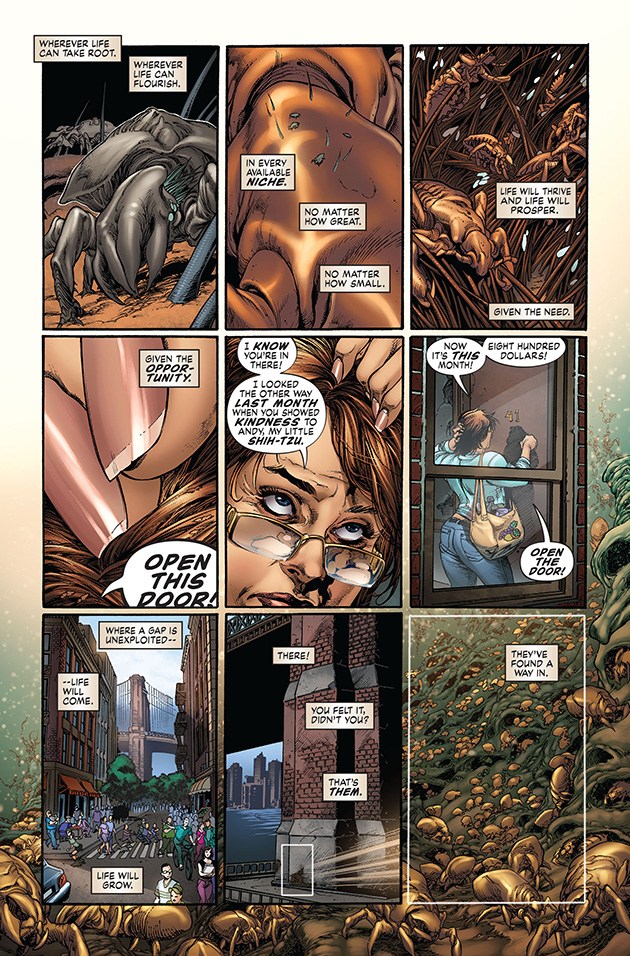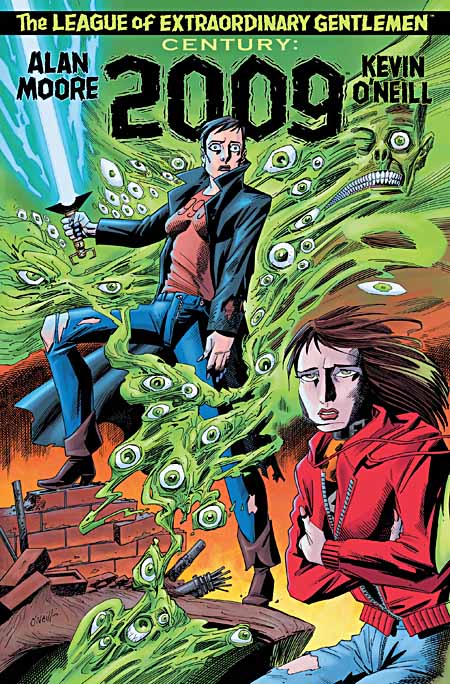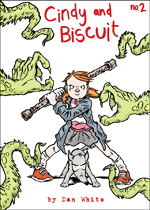The Multiversity #1
September 15th, 2014
There’s always a danger in reviewing the first [issue] of anything, of course, said the wise man. Yeah but fuck it mate seriously who cares? There’s your fair warning so. What follows may get silly.

Andrew: Something I noticed while looking for a reference for something else — that anarchy/heart symbol we were wondering about is the symbol of the superhero flying out of the page in the blazing world section of The Black Dossier. Checking in with Nevins’ annotations of same (reading his annotations for this book before we’ve finished would be cheating, but the old books are fair game), we find that it’s the logo of Ace Hart (a British superhero, not the dog detective), which we all should have known as he appears in Zenith Phase III.
Adam: I like that I couldn’t link it back to a specific superhero, actually. I enjoyed having the space to meditate on how and why it might fit into the kind of space O’Neil and Moore were interested in constructing rather than just see it as a dry reference. So fanwank, yes, but not without purpose. Although the name ‘Ace Hart’ would probably just have added fuel to my reverie’s fire. I imagine Moore would have fun with the symbolic charge there.
Andrew: And one point I don’t think we made before, when discussing to what extent Moore is able to comment on the culture of 2009 as opposed to earlier decades, is just how few characters from 21st century fiction actually appear here. We’ve got the odd background character who doesn’t say or do anything, but in the whole book the only character with a speaking role to have been created in the decade in which the comic is supposedly set is Malcolm Tucker, who’s just a talking head on a TV. Even the Potter characters (none of whom except Potter have more than one line) were created in the mid-1990s — and other than them, there’s not a speaking character in the comic that originated post-1976.
This is a huge change from all the other League volumes, which mixed and matched eras, obviously, but showed a real in-depth knowledge of their time’s popular culture.
p27

Adam: My, isn’t that lava lamp… big.
In case you hadn’t noticed that’s Dr B Coote S.M.B.D: standing for sadism, masochism, bondage, domination one imagines, which sadly loses some of the flexibility of our real world formulation, BDSM. There you’ve got bondage, domination, sadism, masochism or bondage and discipline, dominance and submission, and sadomasochism. More… er… therapeutic options.
Amy: BDSM is considered by some people to be quite an effective form of, well not exactly therapy, but a way of containing and processing painful experiences, particularly those of a sexual nature. Mina has already engaged in mild BDSM with Allan (the infamous “Bite me” scene), probably as a response to the ultimate Dom/Sub relationship she shared with Dracula, so we know she’s the perfect patient in some ways… Saying that, though, it’s hard to imagine anyone as drugged up as Mina conclusively consenting to anything.
p29

Andrew: Notice the spy camera on the corner — a little incidental detail of how the world has changed since the last volume. We grow so used to these things, it’s sometimes hard to remember that in a lot of ways we’ve been in a dystopian future since at least the mid-90s.
League of Extraordinary Gentlemen Century: 2009 thoughts
June 26th, 2012

Andrew: First impressions, this is a truly strange comic. I mean, it’s *good*, but it’s an attempted critique of modern pop-culture by someone who has no idea what modern pop-culture *is* (outside of the work of Armando Iannucci, anyway). I haven’t owned a TV in my adult life, and yet I have a better idea of what the pop-cultural feel of 2009 was than Moore seems to have.
And it’s a shame, because the story Moore wants to tell — of the deterioration of culture since the 1960s — is one that could be plausibly made. But to make it work, one has to criticise the 60s counterculture. Most of the problems in the world today stem, ultimately, from the utter self-obsessed infantilism of the generation that were young adults in 1969 — Moore’s generation, the generation that voted in Thatcher, the generation that made up Blair’s cabinet — but rather than admit the link, Moore has instead basically taken a line of “Weren’t the 60s great until Charles Manson and Altamont, but now the world’s full of young people with their hippity-hoppity music and their pinpods, and I wish it would all be like it used to be.”
But all that said, this is still a great comic and a great conclusion to League Volume 3.
Batman Incorporated: Leviathan Strikes! annocommentations part 2
January 28th, 2012

Um….
For some reason, probably because I found the Chief Man of Bats issue so meh and the following one bloody awful, and because I was in the Isle of Man, I didn’t pick up this, ahem, *special* (way to throw a cover together, DC art Dept!) when it came out a couple of weeks back, but I’m pleased I have now because this book’s back on track in a big way. We all moan about the Big Two, but DC aren’t stupid enough to completely overhaul one of their most popular titles, and, as with Snyder’s book, now that we know Batman Inc will stay pretty much on point after the reboot, I’m prepared to invest myself again.
Now that I know I won’t get hu….
Batman Incorporated: Leviathan Strikes! annocommentations part 1
January 22nd, 2012

For some reason, probably because I found the Chief Man of Bats issue so meh and the following one bloody awful, and because I was in the Isle of Man, I didn’t pick up this, ahem, *special* (way to throw a cover together, DC art dept!) when it came out a couple of weeks back, but I’m pleased I have now because this book’s back on track in a big way. We all moan about the Big Two, but DC aren’t stupid enough to completely overhaul one of their most popular titles, and, as with Snyder’s book, now that we know Batman Inc will stay pretty much on point after the reboot, I’m prepared to invest myself again.
Now that I know I won’t get hurt.
Sniff.
As was somewhat unsurprising, the second part of this story really divided fans. You know my take on this by now. There are problems with Grant’s writing, sure. I know all about them. I’ve been reading him since Zenith. But they have nothing to do with the writer being on bad drugs. If people want a more traditional take, they can read Snyder. If they want a more colourful one that’s not afraid to push the boat out, then Morrison’s the man for them. If you belong to the former group, you should know now that what you’re about to read is going to take it for granted that experimentation in comic books should be the norm rather than the exception. There certainly won’t be any time wasted on justifying such an approach.

Are you sitting comfortably? Is everybody in? The ceremony is about to begin.
http://www.youtube.com/watch?v=pzAEtLPSzRg&feature=related
The remains of PAGE 53
You can see from the film that not only is Terner in a similar get up to his real life counterpart, but that Orlando and Charlie Watts share the same tailor too.
Here’s a song some of you might know…. And that’s just it: like Sympathy For The Devil itself (indeed, the titular Devil himself) Terner’s song never speaks its name, so it may as well be called Sympathy For The Devil too (2). Moore probably intends it that way, the song being just another of the Devil’s disguises, changing shape with whatever reality it finds himself in this time, fictional, real or otherwise, but the beat remaining the same. It occurs to me, actually, that Satan is a League character par excellence, in that one dare not speak his name directly for fear of drawing his attention and so he must be referred to via hints and clues…..

Interview with Kevin O’Neill here
Amy: Forgot to mention that the monster in the picture to the left of Terner two pages previous is from Night of the Demon, and, yes, it is indeed a demon. Night of the Demon, based on M.R. James’ short story Casting the Runes (it’s the entire short story), features yet another Crowleyalike and Haddo death hole/assumed identity, Dr Julian Karswell, a nasty wizard who sets demons on people who attempt to defame him. I probably don’t need to tell you that he meets a sticky end at the hands of one of his own summonings, but I just have, so there you are. It’s funny the way Terner has the picture framed like a family snapshot. Again, it suggests that he doesn’t take this occult business seriously enough. Then again, it probably serves the function of a gargoyle too.
Perhaps it was a gift from ‘Felton’. Maybe it’s signed.

Interview with Kevin O’Neill here
Welcome to the second part of our annocommentations. The idea with these things isn’t to compete with the excellence of Jess Nevin’s annotations, but to supplement them. Jess doesn’t do much mulling over the meanings of his findings, and that’s what these posts are about. So if you ever wondered what Terner being from Performance says about the sort of sexual positions he likes, then you’re in the right place. Oh yeah, and the links aren’t just to dull old Wikipedia pages. Follow them.



